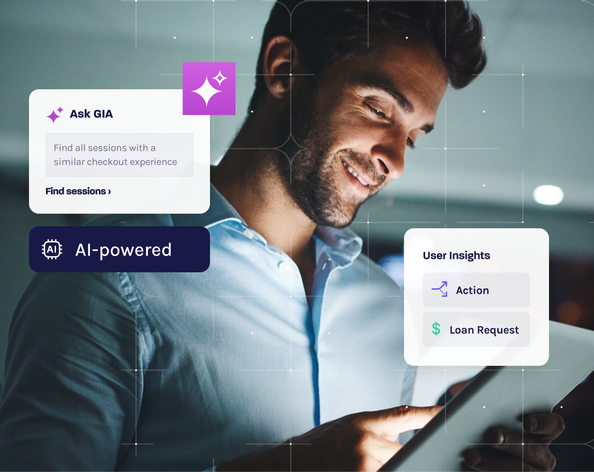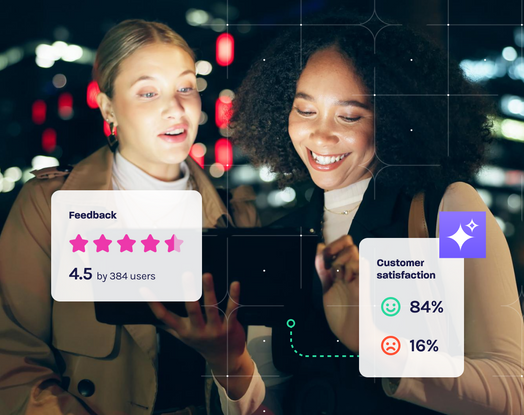
Artificial Intelligence and Customer Experience: 7 Use Cases
Artificial intelligence (AI) is transforming customer experience, redefining how brands engage with customers at every touchpoint. From faster responses to smarter recommendations, generative AI and other AI-powered systems enable seamless interactions and personalized support for modern customer service.
Customer expectations have evolved dramatically in the digital era. Today’s consumers demand frictionless journeys and tailored experiences across channels, raising the bar for businesses to meet customer needs in real time.
Traditional customer experience models struggle to keep pace with this complexity. Legacy tools rely on siloed data and reactive approaches, making it difficult to address the multi-touchpoint journeys of modern customers. AI flips the script by anticipating needs, resolving issues proactively and delivering real-time personalization.
Ready to see what this looks like in practice? Below are seven use cases illustrating how AI is actively reshaping customer experience across industries. Each example shows why forward-thinking organizations are weaving AI into their digital experience solutions.
How Artificial Intelligence Is Transforming Customer Experience
AI in customer experience blends generative AI, machine learning, natural language processing and robotic process automation into a single, data-driven engine that improves satisfaction, loyalty and efficiency. These technologies read every click, tap and swipe, recognize patterns in customer behavior and trigger responses so you can deliver relevant content, recommendations and support with pinpoint accuracy.
Within digital customer journeys, AI acts as both a map and a compass. It captures 100% of session data, stitches together interactions across devices and surfaces the moments that matter most. AI can also highlight friction points, reveal why customers hesitate at checkout and suggest optimizations that keep journeys moving.
Modern engagement is no longer about responding quickly; it’s about anticipating what a customer will need next, ensuring that AI customer service is both proactive and personal. An AI chatbot can answer routine questions around the clock, sentiment analysis flags frustration before it escalates and predictive analytics recommend the best product or offer in the moment.
As customer expectations mount, the next competitive advantage stems from moving beyond rapid response toward foresight and prevention.
The Shift Toward Proactive, AI-Driven Customer Experience
For decades, customer experience strategies centered on resolving complaints after they appeared. AI changes that timeline. By continuously monitoring live sessions and historical trends, intelligent algorithms recognize patterns that hint at friction—declining click velocity, repeated form errors or sudden spikes in page exits—and intervene before dissatisfaction takes hold. This evolution from reactive to proactive customer experience not only protects revenue but fortifies customer trust.
Predictive analytics sits at the heart of this shift. Machine learning models analyze millions of interactions to forecast likely outcomes, whether that’s a cart abandonment, a declined loan application or a surge in call volume. Natural language processing listens to chat logs, voice transcripts and social posts, detecting sentiment so you can escalate high-risk inquiries instantly. Together, these capabilities allow financial institutions to flag fraud in real time and protect customer data.
Glassbox Insights Assistant (GIA) amplifies these advantages. Unlike generic AI tools that sample a fraction of events, GIA ingests 100% of web and mobile interactions, then translates them into conversational insights anyone can use. If you ask, “Why are premium card applicants dropping in step three?” then GIA delivers a concise summary of the struggle, complete with session replays and the statistical impact on revenue. Because GIA is built on Microsoft Azure OpenAI Service, you gain enterprise-grade security, role-based access controls and compliance peace of mind, which are critical in regulated sectors like banking.
By democratizing insight, GIA frees customer experience teams to act faster. Product managers prioritize bug fixes backed by quantified revenue risk, marketers personalize journeys based on real behavioral segments and compliance officers verify that digital flows meet regulatory standards, all within a single, AI-powered workspace.
7 AI Use Cases Transforming Customer Experience
Intelligent automation doesn’t just accelerate workflows, it turns every customer interaction into an opportunity for proactive engagement and measurable ROI. The seven examples below indicate how companies across banking, retail and telecom are using AI customer experience tools to anticipate needs, eliminate friction and drive revenue growth.
1. Saving Revenue with Predictive Error Detection
A leading bank used Glassbox to monitor every digital session and surface anomalies indicating broken flows. As a result, the team spotted a critical checkout error within minutes, fixed it and prevented customer frustration that would have otherwise gone unnoticed. According to the case study, predictive models now protect roughly $1.5 million in yearly revenue.
2. Conversion Optimization with Real-Time Behavior Tracking
In e-commerce, even small tweaks to a promotion can swing revenue. Using Glassbox, one retailer ran live analyses on coupon usage to determine which discount codes generated the highest engagement. The findings allowed marketers to refine offers in flight and cut wasted spend.
3. Personalizing Customer Journeys Through A/B Testing
An online retailer sought faster insight into which page layouts influenced add-to-cart rates. With Glassbox, variant performance was evaluated continuously—no manual tagging required. The study exemplifies how AI-driven anomaly detection accelerated winning insights, boosting conversions without increasing ad spend.
4. Mitigating Fraud With Real-Time AI Alerts
Not all risky transactions look suspicious at first glance. An e-commerce company leveraged Glassbox behavioral analytics to create a dynamic risk score for every session. The platform flagged anomalies, such as rapid address changes or unusual keystroke patterns, triggering secondary verification before checkout, protecting sensitive customer data and minimizing disruption to customer support. This resulted in reduced chargebacks and frictionless shopping for legitimate customers.
5. Reducing Cart Abandonment by Fixing Hidden Friction
A global food brand noticed an unexplained surge in cart drop-offs. Glassbox GIA combed through thousands of sessions and revealed a misaligned JavaScript event preventing payment method selection. Engineers fixed the bug within hours, leading to a significant uptick in completed purchases. This illustrates how AI recovers revenue that traditional analytics can’t expose.
6. Amplifying Voice of Customer Feedback with AI
Contact center transcripts and survey comments often lie dormant in siloed systems. A telecom giant partnered with Glassbox to categorize millions of VoC records in minutes, uncovering a confusing upgrade flow draining revenue. By marrying sentiment analysis with behavioral data and leveraging generative AI, GIA identified actionable fixes and prioritized them by business impact, increasing customer satisfaction scores once updates rolled out.
7. Optimizing Application Performance for Seamless Journeys
Page speed and stability shape first impressions. An online retailer leveraged Glassbox performance analytics to spot a memory leak causing mobile crashes during peak traffic. After the bug was patched, the company added 800 new customers each month.
Building Trust and Transparency in AI-Driven Customer Experience
Customers may love hyper-personalized experiences, yet they won’t embrace them unless they’re confident their data is handled responsibly. When you explain how algorithms make decisions and give customers meaningful control over their information, you convert curiosity into lasting loyalty.
Below are proven ways to embed transparency into your AI customer experience strategy while maintaining the enterprise-grade rigor expected in regulated industries:
State your purpose up front: A concise notice, such as “We use AI to recommend relevant products based on your browsing behavior,” sets clear expectations and aligns with GDPR guidelines.
Offer opt-out and customization controls: Providing customers with the ability to fine-tune notification frequency or disable certain data uses shows respect for autonomy.
Document data flows: Internal mapping clarifies where personal data resides, who can access it and how long it is retained, forming the backbone of compliance audits.
Adopt a privacy-first architecture: Solutions such as the Glassbox platform encrypt data in transit and at rest, apply role-based access and anonymize sensitive fields by default.
Provide explainability features: Session replays annotated with AI algorithms and AI insights enable teams to trace back exactly why a recommendation was made or a fraud alert triggered, building confidence for regulators and customers alike.
By weaving these practices into everyday operations, you foster an environment where innovation and integrity reinforce one another.
Overcoming the Challenges of AI Adoption in Customer Experience
Even with compelling ROI, many organizations discover that deploying AI across customer touchpoints is more difficult than a simple software upgrade. Three obstacles surface most often.
1. Data silos fragment insight: Clickstream logs sit with digital teams, contact-center transcripts reside in a separate CRM and mobile telemetry lives in yet another tool. Without a unified view, algorithms struggle to train on complete journeys, leading to partial or misleading recommendations.
2. Skills gaps slow momentum: Data scientists are scarce, and frontline teams may feel uneasy interpreting model outputs or trusting automated recommendations. Misalignment between technical and business stakeholders can stall promising initiatives.
3. Striking the right balance: Ensuring there is a good balance between automation and human oversight remains a constant challenge. Over-automation risks robotic interactions; under-automation forfeits efficiency gains.
Fortunately, proven solutions exist:
Deploy a unified analytics platform: Glassbox consolidates 100% of web and mobile interactions, breaking down silos so AI models learn from the full customer journey rather than isolated touchpoints.
Democratize insights with tools like Glassbox Insights Assistant (GIA): Its chat-based interface translates complex behavioral data into plain language, allowing any AI agent or product manager to make data-driven decisions.
Build a culture of AI literacy: Regular training sessions, documentation and cross-functional workshops help employees understand both the capabilities and limits of AI customer experience technology.
Establish human-in-the-loop governance: Define clear escalation paths where sensitive decisions, such as credit approvals, fraud flags or complaint resolutions, receive human review to protect fairness and empathy.
Addressing these hurdles upfront paves the way for a sustainable AI-driven customer experience.
FAQs
Q: How does AI help businesses move from reactive to proactive customer engagement?
AI uses predictive models to spot early signs of friction like slow clicks, sentiment shifts or device errors. When detected, generative AI triggers proactive actions, like personalized offers or live support, to prevent churn before it happens.
Q: Which AI tools are essential for delivering 24/7 support?
Key tools include virtual assistants, AI-powered chatbots, real-time analytics like Glassbox with GIA and predictive automation for smart routing and faster responses to customer queries. Together, they provide always-on service while reducing strain on human teams.
Q: How can companies measure ROI from AI-powered customer experience?
Measure outcomes like higher conversions, lower abandonment rates and improved customer satisfaction. Operational metrics and recovered revenue from fixed errors also show clear ROI, with Glassbox linking these results directly to AI insights.
Glassbox: The AI Advantage Helping Elevate Your Customer Experience
AI has become the engine behind predictive personalization, proactive engagement and smarter operations. The real advantage AI brings is how quickly it enables you to turn raw data into action, and this is where Glassbox excels.
By capturing every web and mobile interaction and powering insights through GIA, teams can uncover issues, optimize experiences and drive results faster—all with enterprise-grade privacy.
Ready to see how AI can transform your AI customer service approach? Explore Glassbox’s AI-driven solutions.







